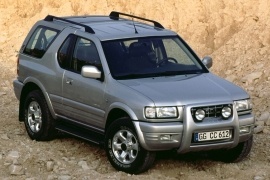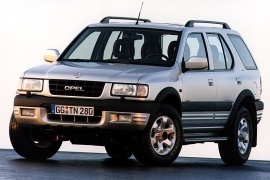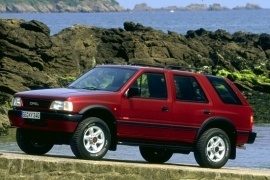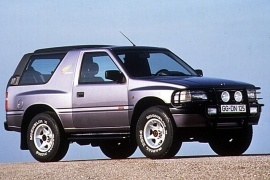
OPEL Frontera
Generations Timeline, Specs and Pictures

The second Frontera generation launched in 1998 came a long with a series of improvements on Opel’s unimpressive SUV.
Rough edges were eliminated, having been replaced by smoother, curvier lines that gave the vehicle a sleek city appearance. Underpinnings were slightly re-adjusted while the engine range was completely renewed. The 2.0i was dropped for good and a 3.2 V6 was added to the line-up. All engines gained 4-valve cylinder heads and increased power output. The 2.5 and 2.8 Liter previous versions were also discarded in favor of the smoother running 2.2 L, available in both petrol and Diesel variants.

The second generation of Frontera Wagons was the result of both aesthetic and functional improvements.
Far from having undergone a conspicuous and cheap make-over, the Wagon was released with a completely new body work and an extended range of engines which were all fitted with 4-valve cylinder heads for increased power output and fuel efficiency. Equipment levels were raised and the previous larger Diesel power units were replaced by a smaller 2.2 version. The gasoline lot received a 3.2 V6 engine that was coupled with a choice of manual/automatic transmissions. Particularly rugged, the V6 developed 205 hp and 290 Nm of maximum torque.

Sporting a slightly restyled body shell, the 1995 facelifted Wagon seemed virtually identical with the ‘92 released model.
However, heavy internal modifications were made. To begin with, the engine range was replaced with a completely new line-up comprised of one petrol and two Diesel power units, ranging in displacement from 2198 cc and 2771 cc. The previously released 2.4i gasoline and 2.3 turbocharged Diesel engines were discarded in favor of the more fuel efficient 2.2i and larger 2.5 TDS and 2.8 TDi, respectively. All versions were available with a 5-step manual transmission only.

The 1995 upgrades brought forth an extended engine range as well as some minor body shell touches.
Suspension was slightly improved as was the overall structure of the vehicle which was now available both as a soft top and a hardtop. The classic 2.0 injected petrol engine was added a 2.5 and a 2.8 Turbodiesel. Although the Diesel were better on rough terrain and pulling due to a significant torque increase, power output was only 4 hp greater than that of the ‘93 released model. However, Diesels were slightly more fuel efficient than the gasoline-powered versions.

Marking Opel’s involvement in the SUV market segment, the Opel Frontera Sport failed to achieve greatness.
Despite its high ground clearance, sturdy chassis and 116 hp 2.0i petrol engine, the car was far from being among the top performs i its class at the time. Leaving engine problems and performance asides (the car was almost twice as heavy as a Corsa but greatly underpowered), some consumer reports have indicated numerous suspension and electric systems glitches. On top of that, the camshaft is said to be a part that unfortunately does not outlive others.

General Motors, Isuzu, and Honda joined forces and developed an SUV sold under different badges across the world.
In Europe, that SUV was known as the Opel Frontera.
Since GM had some shares in Isuzu’s stakes, it was considered good to develop an SUV together. It also asked Honda, who tried to expand its portfolio in the U.S., to join the club and bring its V6 gasoline engine. For the European market, instead, GM prepared only GM-sourced and Isuzu turbodiesel powerplants.
As part of General Motors, Opel was entrusted with the sales of the three- and five-door version of the newly developed SUV and launched it on the market under the Frontera nameplate. The longer version benefited showed a squared-looking body. Its rectangular headlights, flared wheel arches, and raked-forward C-pillars made the car look modern for those times when most off-road vehicles featured flat straight tailgates.
Inside, the squared lines continued and matched the exterior design. Thanks to the longer wheelbase than for the three-door version, the Frontera Wagon provided two seats at the front and a folding bench in the rear. Opel installed a similar dashboard with its siblings sold under Honda, Chevrolet, or Isuzu badges. The squared instrument cluster was narrow, just enough to cover the dials and host a few buttons on its sides. On the center console, the carmaker installed the gear stick and the lever for the high and low transfer box.
Under the hood, Opel installed its inline-four gasoline engines and a turbodiesel developed by Isuzu. The front independent suspension and the rigid rear axle made it a good all-around vehicle, comfortable enough on the streets but not afraid to tackle some muddy roads or trials.























































